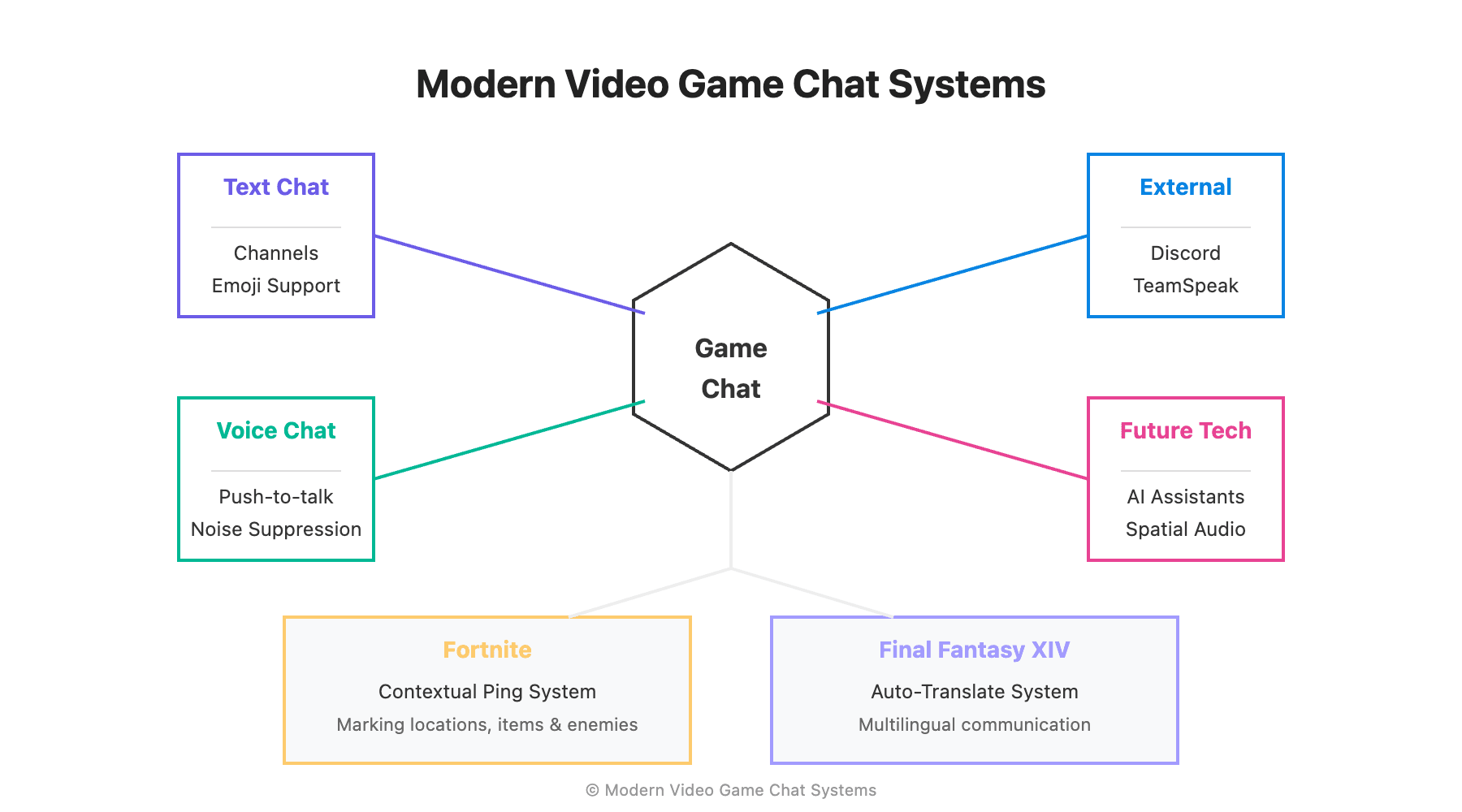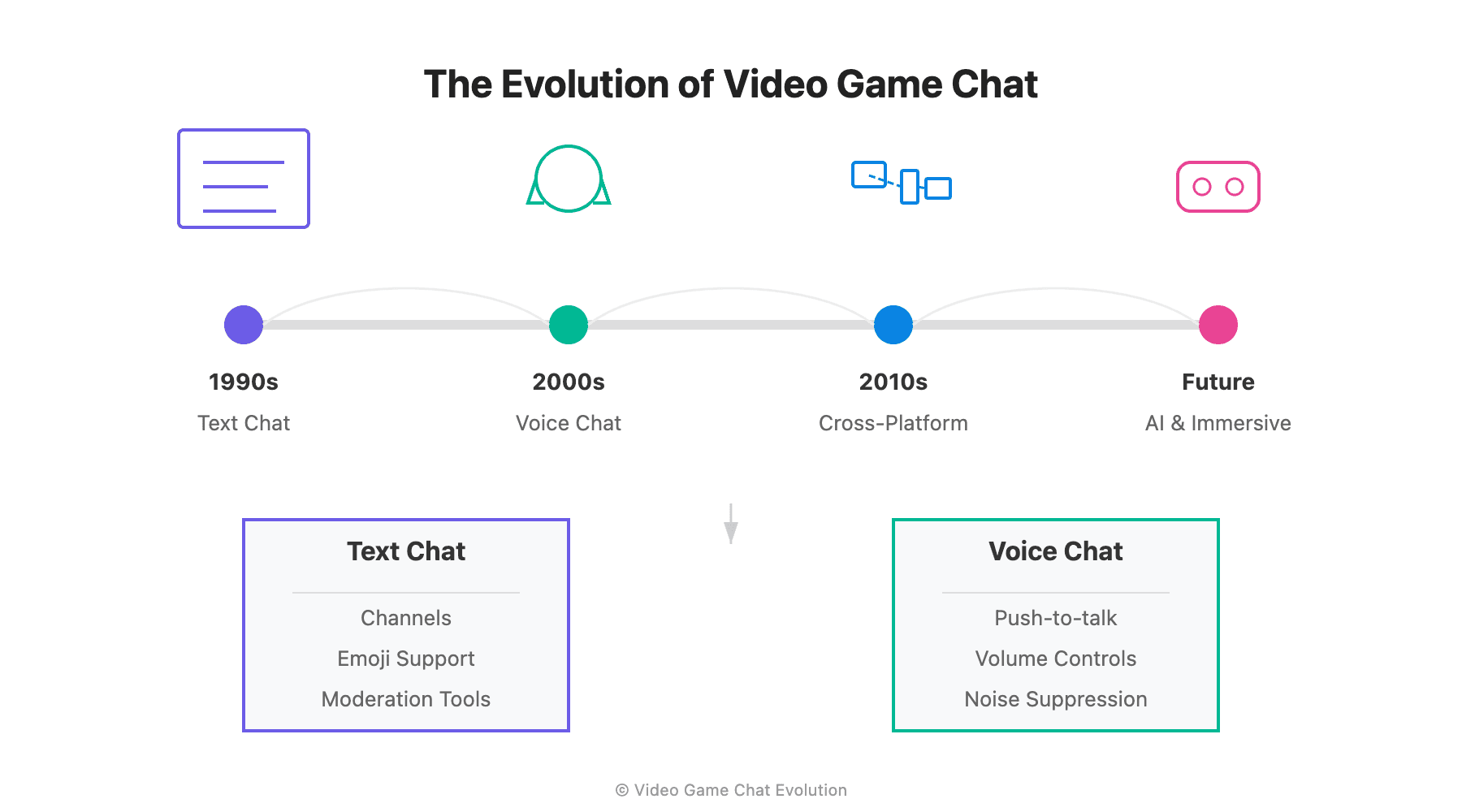In the evolving landscape of video games, one feature stands as the backbone of multiplayer experiences: video game chat. From coordinating complex raid strategies to simply sharing moments of triumph with friends, in-game communication systems have transformed gaming from a solitary activity into a thriving social ecosystem.

What Is Video Game Chat?
Video game chat refers to the communication systems built into games that allow players to interact with each other in real-time. These systems typically come in two primary forms:
- Text chat
- Typed messages that appear in a dedicated chat window or overlay
- Voice chat
- Real-time audio communication between players
Modern video game chat systems often incorporate additional features like emoji support, private messaging, group channels, and moderation tools to create a more robust communication experience.
The Evolution of Video Game Chat

Early Days: Text-Based Beginnings
The earliest multiplayer games relied on simple text chat systems. Games like EverQuest (1999) and Ultima Online (1997) featured basic chat windows where players could communicate through typed messages. These early systems were functional but limited, often requiring players to pause gameplay to type responses.
Voice Chat Revolution
The introduction of voice chat in the early 2000s revolutionized in-game communication. Suddenly, players could coordinate actions without taking their hands off the controls. Xbox Live, launched in 2002, was among the first mainstream gaming services to integrate voice chat directly into the console experience.
Modern Integrations
Today's video game chat systems are sophisticated communication hubs that extend beyond the game itself. Features like:
- Cross-platform communication
- Rich media sharing (images, videos, GIFs)
- Integration with external platforms like Discord
- Accessibility features including text-to-speech
- AI-powered moderation tools
These advancements have made video game chat an essential component of the gaming experience rather than just an add-on feature.
Why Video Game Chat Matters
For Players
- Enhanced coordination: Complex team-based games like MOBAs and tactical shooters depend on fast, clear communication
- Community building: Chat systems facilitate friendships and communities that extend beyond individual play sessions
- Knowledge sharing: New players can learn from veterans through direct communication
- Increased immersion: In-game communication adds depth to role-playing experiences and shared virtual worlds
For Developers
- Increased player retention: Games with strong social components typically see longer player engagement
- Reduced toxicity: Well-designed chat systems with proper moderation tools create healthier communities
- Valuable feedback: Direct player communication provides insights for game improvements
- Competitive advantage: Robust chat features can differentiate a game in a crowded market
Essential Features of Modern Video Game Chat
Today's players expect certain core features from any video game chat system:
Text Chat Essentials
- Channel organization: Public, team, guild, and private messaging options
- Customization: Font options, chat filters, and notification settings
- Moderation tools: Reporting systems, word filters, and spam protection
- Emoji and reaction support: Non-verbal communication options
- Chat history: Access to previous conversations
Voice Chat Must-Haves
- Push-to-talk options: Allowing players to control when their microphone is active
- Volume controls: Individual and group volume adjustments
- Noise suppression: Background noise filtering
- Voice activity detection: Automatic microphone activation when speaking
- Muting capabilities: Options to mute specific players or all voice chat
Advanced Features
- Cross-platform integration: Seamless communication between PC, console, and mobile players
- Accessibility options: Closed captioning for voice chat, screen reader compatibility
- Friend management: Adding, grouping, and status visibility for contacts
- Rich media sharing: Support for images, videos, and other media types
- Mobile companion apps: Extending chat functionality outside the game
Implementing Video Game Chat: Technical Considerations
Architecture Choices
When implementing video game chat, developers typically choose between:
- Peer-to-peer: Direct connections between players, ideal for small groups but difficult to scale
- Client-server: All communication passes through central servers, offering better control but higher infrastructure costs
- Hybrid approaches: Using different models for different types of communication
Technology Stack
Common technologies used in video game chat systems include:
- WebSockets: For real-time text communication
- WebRTC: For peer-to-peer voice communication
- STUN/TURN servers: For NAT traversal in voice chat systems
- Redis/Pub-Sub systems: For scalable message distribution
- Database integration: For message history and user preferences
Development Challenges
Implementing robust video game chat involves overcoming several technical hurdles:
- Latency management: Ensuring messages are delivered promptly
- Scalability: Supporting thousands of concurrent users
- Security concerns: Protecting user data and preventing exploitation
- Cross-platform compatibility: Ensuring consistent experience across devices
- Bandwidth optimization: Especially important for voice communication
Creating a Positive Chat Environment
Combating Toxicity
Toxicity in video game chat remains one of the industry's biggest challenges. Effective strategies include:
- Clear community guidelines: Establishing expectations for behavior
- Automated moderation: Using AI to detect harmful language
- Human moderation teams: Reviewing reports and making judgment calls
- Progressive punishment systems: Escalating consequences for repeat offenders
- Positive reinforcement: Rewarding helpful and constructive communication
Privacy and Safety
Protecting players in chat environments requires:
- Parental controls: Allowing customization of chat access for younger players
- Reporting mechanisms: Simple systems for flagging problematic behavior
- Block functions: Empowering players to control who can contact them
- Data protection: Secure handling of communication data
- Age verification: Where appropriate for adult content
Alternative and Supplementary Chat Solutions
While in-game chat is valuable, many players use additional tools:
Discord Integration
Many games now feature direct Discord integration, allowing players to:
- Join game-specific servers automatically
- Display in-game status on Discord
- Launch games directly from Discord
- Share game invites through Discord channels
Other External Solutions
- TeamSpeak: Popular for its low latency and server control
- Mumble: Open-source voice chat favored for its audio quality
- Console party systems: Built-in voice chat on PlayStation, Xbox, and Nintendo platforms
Future of Video Game Chat
The horizon for video game chat includes several exciting developments:
AI Assistants
AI-powered chat assistants that can:
- Translate messages between languages in real-time
- Provide contextual information about game elements
- Suggest responses or commands based on game state
- Filter toxic content before it reaches other players
Enhanced Voice Technology
Advancements in voice technology bringing:
- Voice changing and modulation features
- Spatial audio for position-based communication
- Improved noise cancellation
- Voice command integration with game functions
Immersive Communication
As VR and AR gaming grows, expect:
- Hand gesture and body language communication
- Facial expression capture and avatar mirroring
- Haptic feedback paired with voice communication
- 3D positional audio for location-based chat
Case Studies: Innovative Video Game Chat Systems
Fortnite's Ping System
Epic Games revolutionized non-verbal communication with a contextual ping system that:
- Allows players to mark locations, items, and enemies
- Automatically generates appropriate voice lines
- Transcends language barriers
- Provides accessibility for players without microphones
Apex Legends' Smart Comms
Building on Fortnite's innovation, Apex Legends created an even more robust ping system with:
- Expanded contextual awareness
- Character-specific voice lines
- Strategic suggestion capabilities
- Integrated with standard voice chat
Final Fantasy XIV's Auto-Translate
Square Enix addressed the international nature of MMO communities with:
- Built-in phrase translation system
- Categorized common phrases and terms
- Symbol indicators for translated content
- Support for multiple languages
Best Practices for Players
Etiquette Tips
- Use push-to-talk in busy environments
- Keep messages relevant to the game context
- Be mindful of timing for important communications
- Respect different communication preferences
- Remember cultural and language differences
Technical Optimization
- Invest in a quality microphone for clearer communication
- Use headphones to prevent echo
- Position microphone appropriately
- Adjust sensitivity settings for optimal voice activation
- Test your setup before important game sessions
Conclusion
Video game chat has evolved from a simple text box to sophisticated communication ecosystems that enhance gameplay, build communities, and create memorable shared experiences. As technology continues to advance, we can expect even more immersive and intuitive ways for players to connect in virtual worlds.
Whether you're a developer implementing chat features or a player looking to maximize your communication potential, understanding the nuances of video game chat is essential in today's interconnected gaming landscape.
Want to level-up your learning? Subscribe now
Subscribe to our newsletter for more tech based insights
FAQ